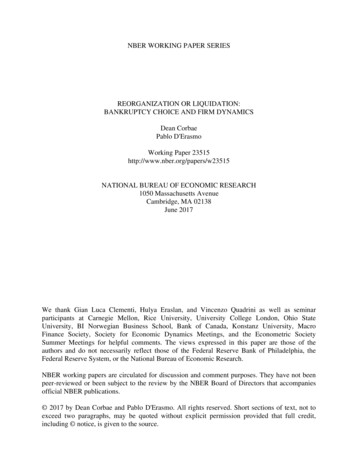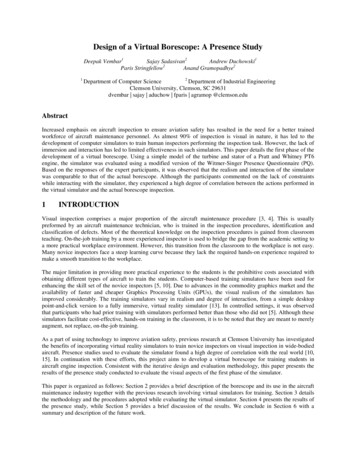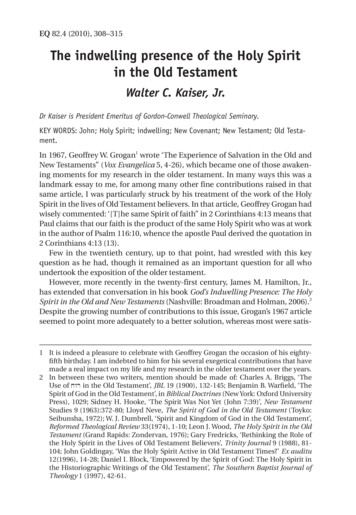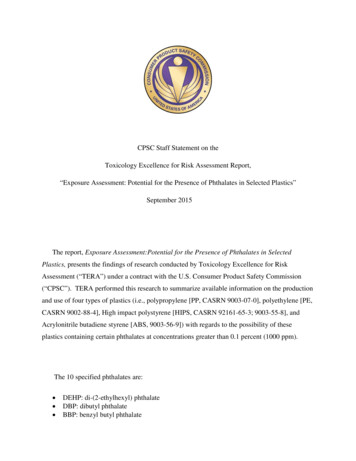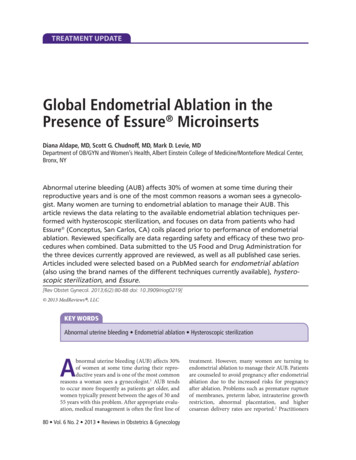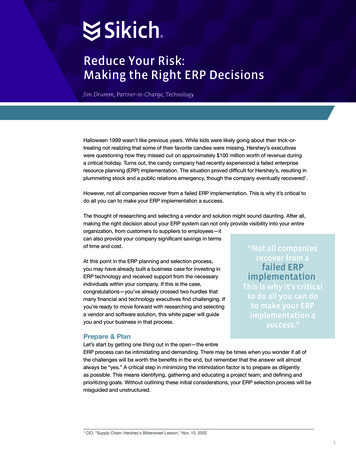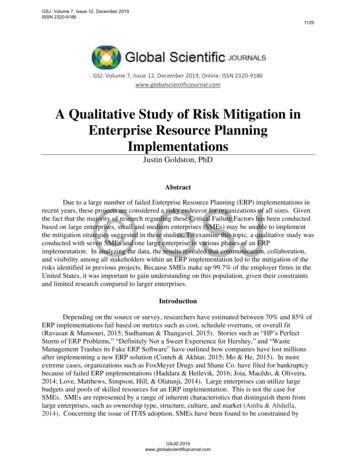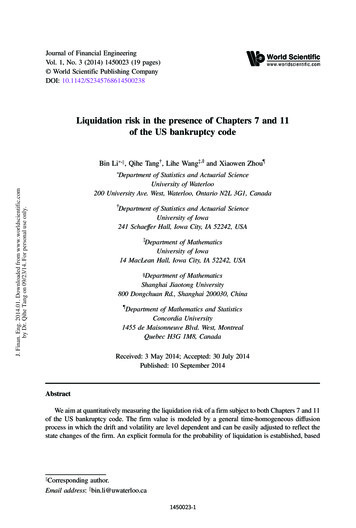
Transcription
Journal of Financial EngineeringVol. 1, No. 3 (2014) 1450023 (19 pages) World Scientific Publishing CompanyDOI: 10.1142/S2345768614500238Liquidation risk in the presence of Chapters 7 and 11of the US bankruptcy codeBin Li*,k, Qihe Tang†, Lihe Wang‡,§ and Xiaowen Zhou¶*DepartmentJ. Finan. Eng. 2014.01. Downloaded from www.worldscientific.comby Dr. Qihe Tang on 09/23/14. For personal use only.of Statistics and Actuarial ScienceUniversity of Waterloo200 University Ave. West, Waterloo, Ontario N2L 3G1, Canada†Department of Statistics and Actuarial ScienceUniversity of Iowa241 Schaeffer Hall, Iowa City, IA 52242, USA‡Department of MathematicsUniversity of Iowa14 MacLean Hall, Iowa City, IA 52242, USA§Department of MathematicsShanghai Jiaotong University800 Dongchuan Rd., Shanghai 200030, China¶Department of Mathematics and StatisticsConcordia University1455 de Maisonneuve Blvd. West, MontrealQuebec H3G 1M8, CanadaReceived: 3 May 2014; Accepted: 30 July 2014Published: 10 September 2014AbstractWe aim at quantitatively measuring the liquidation risk of a firm subject to both Chapters 7 and 11of the US bankruptcy code. The firm value is modeled by a general time-homogeneous diffusionprocess in which the drift and volatility are level dependent and can be easily adjusted to reflect thestate changes of the firm. An explicit formula for the probability of liquidation is established, basedkCorresponding author.Email address: kbin.li@uwaterloo.ca1450023-1
B. Li et al.on which we gain a quantitative understanding of how the capital structures before and duringbankruptcy affect the probability of liquidation.Keywords: Bankruptcy; liquidation; partial differential equation; time-homogeneous diffusion; twosided exit problem.JEL Classification: G33; C022010 Mathematics Subject Classification: Primary 91G80; Secondary 62P05; 60J60J. Finan. Eng. 2014.01. Downloaded from www.worldscientific.comby Dr. Qihe Tang on 09/23/14. For personal use only.1. IntroductionStemming from Merton (1974) and Black and Cox (1976), numerous structuralmodels have been proposed in which bankruptcy and liquidation are usuallytreated as the same event that the firm value reaches an absorbing low barrier. Inthe real world, however, the procedures of bankruptcy and liquidation as describedin the US bankruptcy code are rather complicated. When a firm is unable to serviceits debt or pay back its creditors but its fiscal situation is not severe, it is usuallygiven the right to declare bankruptcy under Chapter 11 of reorganization ratherthan Chapter 7 of immediate liquidation. Chapter 11 allows the firm to remain incontrol of its business operations with a bankruptcy court providing oversight. Thecourt grants the firm a certain observation period during which the firm managercan restructure its debt. The debtor usually proposes a plan of reorganization tokeep its business alive and pay back the creditors over time. The reorganizationplan may either succeed or fail. For the latter case, Chapter 11 will be converted toChapter 7 governed by §1,019 of the US bankruptcy code and the firm may beforced to be liquidated.Warren and Westbrook (2009) showed empirical evidences for the conclusionthat the Chapter 11 system offers a realistic hope for troubled businesses to turnaround their operations and rebuild their capital structures. Lee et al. (2011) foundthat entrepreneur-friendly bankruptcy laws such as Chapter 11 is significantlycorrelated with the rate of new firm entry. See also Hotchkiss (1995), Bris et al.(2006), Denis and Rodgers (2007), Annabi et al. (2012) and Christensen et al.(2013) for related empirical studies of the role of Chapter 11.Under these practical considerations, many recent works in the literature ofcorporate finance have included Chapter 11 reorganization proceedings and madea distinction between bankruptcy and liquidation. In the works of Moraux (2004),François and Morellec (2004), Galai et al. (2007), Broadie and Kaya (2007), andDai et al. (2013), among others, the liquidation time is modeled by the first timethe firm value constantly/cumulatively stayed below the bankruptcy barrier over agrace period granted by the bankruptcy court. However, in these works only the1450023-2
J. Finan. Eng. 2014.01. Downloaded from www.worldscientific.comby Dr. Qihe Tang on 09/23/14. For personal use only.Liquidation risk in the presence of Chapters 7 and 11bankruptcy barrier was considered and, hence, the firm is not necessarily liquidated even when its value is extremely low, which violates the principle of limitedliability.On the other hand, Paseka (2003) and Broadie et al. (2007) explicitly incorporated both the bankruptcy and the liquidation barriers in their models. In thispaper, we shall follow the Chapters 7 and 11 bankruptcy and liquidation modelproposed by Broadie et al. (2007).We model the firm value by a general time-homogeneous diffusion process.A merit of this model is that the drift and volatility of the firm value are leveldependent and can be easily adjusted to reflect the state changes of the firm. Ourderivations are mainly based on the partial differential equations (PDE) and theperturbation techniques, the latter of which are recently developed for stochasticprocesses; see e.g., Dassios and Wu (2010), Landriault et al. (2011) and Li andZhou (2013). Therefore, we expect that this study can be extended to other valueprocesses, such as L evy-driven models and Markov regime-switching models.The major contribution of this paper is to provide an analytical formula for theprobability of liquidation, which is at the core of financial risk management. Wewould like to remark that our results have immediate applications to pricingcorporate bonds and other derivatives such as credit default swaps. In particular, inlight of this work, it is anticipated that the recent study of Parisian options byChesney et al. (1997), Chesney and Gauthier (2006), Anderluh and van der Weide(2009), Dassios and Wu (2010), Dassios and Wu (2011) and Albrecher et al.(2012) among others, can be extended to more elaborate options formulated in thecurrent new framework.Our paper is also relevant for the recent study of Parisian ruin in the context ofrisk theory originating from the study of Parisian options. The concept of Parisianruin was first introduced by Dassios and Wu (2008) under the Brownian motionframework. Later on, the underlying structure was generalized to the L evyframework by Dassios and Wu (2009), Czarna and Palmowski (2011) and Loeffenet al. (2013). However, these works only investigated the so-called Parisianstopping time, which corresponds to the liquidation time incurred by Chapter 11 ofbankruptcy code in our framework. By further incorporating the feature ofChapter 7, our paper essentially studies the minimum of a Parisian stopping timeand a first passage time. In other words, we monitor not only the length ofexcursions below the bankruptcy barrier but also the depth. Another related paperis by Gauthier (2002) who also studied such a mixture of the two stopping times.However, Gauthier's analytical results are only in the framework of Brownianmotion processes and are rather involved. In addition, our methodology, whichcombines the PDE and perturbation techniques, is very different from Gauthier's.1450023-3
J. Finan. Eng. 2014.01. Downloaded from www.worldscientific.comby Dr. Qihe Tang on 09/23/14. For personal use only.B. Li et al.There are several limitations of our paper. First, the perturbation techniquesused in this paper cannot be easily extended to time inhomogeneous models. But ifthe firm value process is piecewise time homogeneous, one can first derive theLaplace transform of the liquidation time for each time period and then calculatethe probability of liquidation by Laplace inversion techniques. Second, as acommon drawback of structure models driven by Brownian motion, the short-termcredit spread of our time-homogeneous diffusion model tends to zero as the maturity approaches zero. This can be overcome by incorporating downward jumpsor considering stochastic bankruptcy barriers; see e.g., Brigo et al. (2013,Sec. 3.1.9). Third, calibration of the time-homogeneous diffusion structure is beyond our paper. It is difficult to calibrate the process from credit default swap(CDS) data. However, recent studies show that one can calibrate time-homogeneous diffusion models from perpetual American options for different strikes; seee.g., Ekstr om and Hobson (2011).The rest of the paper is organized as follows. The probability of liquidation isdefined and the time-homogeneous diffusion model is introduced in Sec. 2. Analytical results for the probability of liquidation are presented in Sec. 3. Somenumerical studies are implemented in Sec. 4. Finally, two major proofs of ourpaper are postponed to Sec. 5.2. Modeling2.1. The probability of liquidationWe follow Broadie et al. (2007) to describe the procedures of bankruptcy andliquidation by incorporating the Chapter 11 reorganization, the Chapter 7 liquidation, the conversion from Chapter 11 to Chapter 7, and the grace period inChapter 11. Formally, suppose that the firm value is modeled by a generalstochastic process X ¼ fXt , t 0g starting with X0 ¼ x0 . For a real numberx x0 , denote by Tx the first time when the process X down-crosses the level x;that is,Tx ¼ infft 0 : Xt xg:Hereafter, we follow the convention that inf ; ¼ 1 and sup ; ¼ 0. For x x0,the first time when the process X up-crosses the level x can be defined similarly.Let a b and c 0 be three endogenously determined constants, with ainterpreted as the Chapter 7 liquidation barrier, b as the Chapter 11 reorganizationbarrier, and c as the duration of a grace period in Chapter 11 granted by thebankruptcy court. Let b ðcÞ be the first time when the process X has continuously1450023-4
Liquidation risk in the presence of Chapters 7 and 11stayed below level b for c units of time, namely, b ðcÞ ¼ infft 0 : t gt cgwith gt ¼ supfs t : Xs bg:Then the liquidation time is defined byJ. Finan. Eng. 2014.01. Downloaded from www.worldscientific.comby Dr. Qihe Tang on 09/23/14. For personal use only.Ta b ðcÞ:Hereafter, we denote by u v ¼ minfu, vg and u v ¼ maxfu, vg.This definition of liquidation can be verbally explained as follows. Once thefirm value is below the reorganization barrier b, the firm declares Chapter 11 totrigger the reorganization procedure and an invisible distress clock starts ticking. Ifthe firm value rebounds and rises above the barrier b before the grace period runsout, Chapter 11 is resolved and the distress clock is reset to zero. However, thefirm may be eventually liquidated under Chapter 7 in case the reorganization plandoes not succeed. There are two scenarios of liquidation: either the firm valuedrops below the liquidation barrier a or the time the firm spends in bankruptcyexceeds the grace period c granted by the bankruptcy court. Figure 1 of Broadieet al. (2007) depicts these scenarios.The probability of liquidation subject to Chapter 7 and 11 with the liquidationbarrier a, the reorganization barrier b, and the duration c of a grace period, or, inshort, the probability of liquidation subject to the triple ða, b, cÞ, is defined byqðx0 ; a, b, cÞ ¼ Px0 fTa b ðcÞ 1g,a b x0 , c 0:ð1ÞThroughout the paper, we denote by Px the law of X with X0 ¼ x. Note that thisprobability of liquidation is in the infinite-time horizon. It provides us with aquantitative understanding of the firm's liquidation risk in the long run. Besides,letting a # 1 in (1) yieldsqðx0 ; 1, b, cÞ ¼ Px0 f b ðcÞ 1g:This is essentially the probability of liquidation introduced by François andMorellec (2004), Broadie and Kaya (2007) and Dai et al. (2013) in finance, or theParisian ruin probability studied in Dassios and Wu (2009), Czarna and Palmowski(2011) and Loeffen et al. (2013) in risk theory.We slightly extend the domain of the probability of liquidation qðx; a, b, cÞin (1) to x a. It is sometimes more convenient to carry out our discussions on thecorresponding survival probability defined bypðx; a, b, cÞ ¼ 1 qðx; a, b, cÞ ¼ Px fTa b ðcÞ ¼ 1g:ð2ÞHereafter, we often drop the arguments a, b, c from pðx; a, b, cÞ and qðx; a, b, cÞwhenever we proceed with general discussions without emphasis on them.1450023-5
B. Li et al.2.2. Time-homogeneous diffusion processesWe model the firm value by a general time-homogeneous diffusion processX ¼ fXt , t 0g, defined on a filtered probability space ð , F , PÞ, with dynamicsdXt ¼ ðXt Þdt þ ðXt ÞdWt ,ð3ÞJ. Finan. Eng. 2014.01. Downloaded from www.worldscientific.comby Dr. Qihe Tang on 09/23/14. For personal use only.where X0 ¼ x0 is the initial value and fWt , t 0g is a standard Brownian motion.Denote by fF t , t 0g the natural filtration generated by fWt , t 0g. As usual,assume that ð Þ and ð Þ 0 satisfy the conditions of the existence anduniqueness theorem for the stochastic differential equation (3); namely, there existsa constant K 0 such that, for all x, y 2 R,j ðxÞ ðyÞj þ j ðxÞ ðyÞj Kjx yj, 2 ðxÞ þ 2 ðxÞ Kð1 þ x 2 Þ:ð4ÞThen the unique strong solution of (3) possesses the strong Markov property; seeGĪhman and Skorohod (1972, pp. 40 and 107).Here and thereafter, we restrict X to the time-homogeneous diffusion process (3). Since X has continuous sample paths, the two first passage times fromabove or below a barrier x 2 R are identical to the first hitting timeTx ¼ infft 0 : Xt ¼ xg:Besides, since the probability of liquidation qðx0 ; a, b, cÞ is obviously monotonedecreasing in c, letting c # 0 in (1) yieldsqðx0 ; a, b, 0Þ ¼ Px0 fTb 1g,ð5Þwhile letting c " 1 yieldsqðx0 ; a, b, 1Þ ¼ Px0 fTa 1g:ð6ÞRelation (5) is due to Tb ðcÞ # Tb as c # 0 and (6) is due to b ðcÞ c a.s. Hence, theduration c serves as a bridge connecting the two traditional probabilities ofbankruptcy.The two-sided exit problem for the diffusion process X has been well studied. It
interpreted as the Chapter 7 liquidation barrier, b as the Chapter 11 reorganization barrier, and c as the duration of a grace period in Chapter 11 granted by the bankruptcy court. Let bðcÞ be the first time when the process X has continuously B. Li et al. 1450023-4 J. Finan. Eng. 2014.01. Downloaded from www.worldscientific.com by Dr. Qihe .
